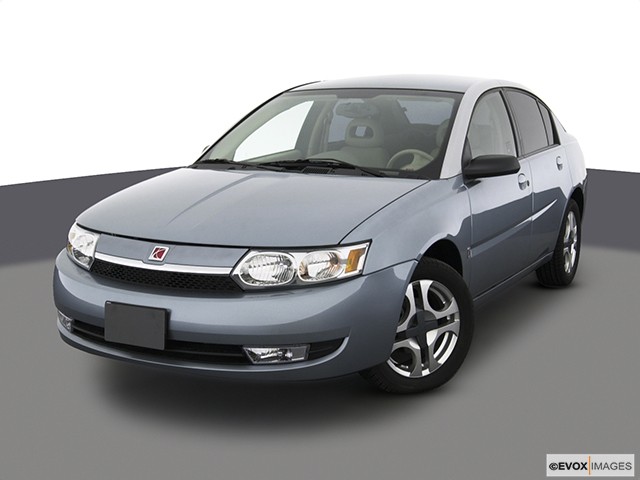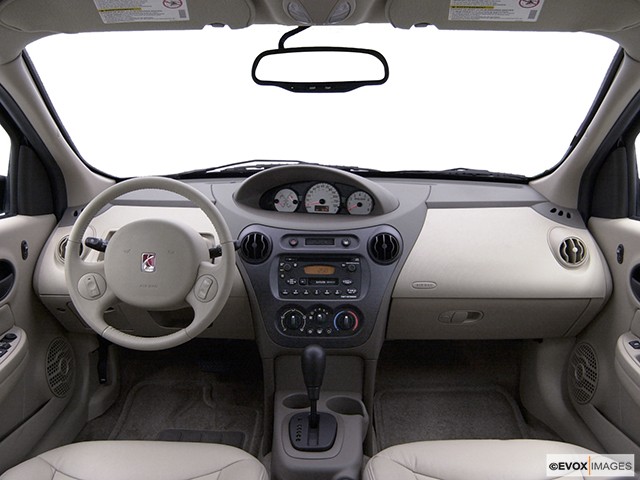The 2003 Saturn Ion was a short-lived budget car. When it was new it was adequate for the price. As a used car priced in the same range as the Focus, Elantra, and Corolla, it feels like a waste of money.

Is the 2003 Saturn Ion a Good Used Car?
- Overall Rating 6/10 – All the Ion had going for it twenty years ago was that it was cheap. As a used car, it’s overpriced.
- Interior, Comfort & Cargo 6/10 – The trunk space and suspension are decent. Everything else is terrible. Cramped, rigid, and upholstered in cheap-feeling cloth trim.
- Reliability 7/10 – The engine and power train might just reach 250,000 miles. But only if you feel like paying for a new rack and pinion steering system and dozens of electrical fixes along the way.
- Safety 6/10 – The Ion is saddled with dated safety tech and lousy crash test scores.
- Gas Mileage 7/10 – At 26/33 miles to the gallon, city/highway, the Ion is cheap to refuel.
- Value 5/10 – There’s no reason a 2003 Ion should cost the same as a Ford Focus.
What Do Critics Say About the 2003 Saturn Ion?
Consumer Reports “found the Ion to be very disappointing.” Despite a comfortable ride and smooth handling, the cramped, uncomfortable seats, cheap interior, and wobbly steering turned them off of the car. The noisy, inefficient engine didn’t help much, either.
Kelley Blue Book users were a bit kinder, calling the Ion fun to drive and reliable, giving it an 80% recommendation. Flaky, low-grade exterior paint and cheap plastic interior earned the car a few red marks.
Edmunds liked the overall layout of the coupe, with its rear-access doors and surprisingly generous cargo space. They felt the build quality wasn’t up to par, and they weren’t so hot on the quirky visual design of the car.
What Common Problems Does the 2003 Saturn Ion Have?
Steering issues have been one of the 2003 Ion’s biggest problems, going by National Highway Traffic Safety Administration stats, where steering comprises 136 of 761 complaints total. Power steering tends to go out, and the rack and pinion system may need replacement before you reach 250,000 miles.
Electrical problems take a major lead, making up around half of the total with 382 complaints on file. The main issue here is that the ignition won’t always work as intended. Sometimes the car won’t start, sometimes it won’t turn off, sometimes the key can’t be removed from the ignition.
The good news is that transmission issues aren’t incredibly common. There are 60 powertrain complaints on file, but a lot of these are for issues with the ignition or the control module. But, there are a handful of reports of the transmission totally failing at well under 100,000 miles.
There are 7 recalls for the Ion, and if you look at the general pattern on the NHTSA page, the engine and transmission are built to go the distance. But the steering is another matter, same with the cheap electrical components.
How Long Will the 2003 Saturn Ion Last?
Based on reports from drivers, you should expect a 2003 Saturn Ion to last a minimum of 200,000 miles before it gets to be too expensive to keep maintaining. The engine and powertrain could easily reach 250,000 with regular oil changes, but given the recurring electrical and steering issues, it might not be worth the hassle.
RepairPal estimate an annual maintenance cost of $338, with clutch replacements being the most expensive common fix, starting at $1,462. You also need to be ready to shell out for new AC compressors, which can cost well over a grand, and new thermostats averaging close to five hundred dollars.
How Is the Technology?
Entertainment technology is adequate for 2003. The high-end Ion 3 comes with a CD player. That’s about as fancy as it gets here. You might want to invest in a pair of portable speakers for your phone.
Safety features are, likewise, adequate for 2003. Dual stage airbags, LATCH, an emergency trunk release handle, but no anti-lock brakes or traction control. The car earned excellent crash test ratings from the NHTSA, and miserable ratings from the Insurance Institute for Highway Safety.
Is the 2003 Saturn Ion a Good Value?
The 2003 Saturn Ion isn’t a great deal. An entry level Ion 1 typically lists at around $3,456, which isn’t a terrible price for a car this old, but when you add in all the money you’re going to spend replacing clutches and power steering parts and broken electronics and AC compressors, it’s going to cost you more than a new car might.
An Ion 3 sells for around a thousand bucks higher than an Ion 1, and you’re not getting much more for that price than some power windows. The Ion would be worth it at around eight hundred dollars. If you’ve got four grand to spend on a used car, consider a Civic or a Focus from the same year.
What are the Different Models of the 2003 Saturn Ion?
The Ion is offered in three trims, the self-explanatory 1, 2, and 3. You almost have to squint to see the difference between them.
The entry-level Ion 1 features:
- AM/FM stereo with four speakers
- Cloth seat trim
- Two 12v power outlets
- Remote hood release
The mid-range Ion 2 adds:
- Manual air conditioning
- CD player
- Power door locks
With the high-end Ion 3 you’re adding:
- Power windows
- Fog lights
- Remote keyless entry
- Premium cloth seat trim
What Engines Come In the 2003 Saturn Ion?
- The Ion comes packed with a 2.2L inline-four producing 145 lb.-ft. of torque and 140 horsepower. This is paired to a 5-speed automatic transmission and configured in front wheel drive. While the Ion might not be the strongest or fastest car in its size class, 26/33 miles to the gallon, city/highway, ain’t bad.
What Colors Does the 2003 Saturn Ion Come In?
How Comfortable Is the 2003 Saturn Ion?
The Ion rides smooth. That’s the kindest thing anyone has to say about the car when it comes to comfort. The seats are rigid, the back row is a tight squeeze with just 49 inches of hip room, and even the premium cloth trim feels cheap.
Drivers will usually forgive these issues in a work truck or a muscle car, where convenience and comfort take second priority behind performance. But the Ion is oriented around neither performance nor comfort, leaving you to wonder what you’re getting out of this tradeoff.
How Much Storage Space Does the 2003 Saturn Ion Have?
The 2003 Saturn Ion has about 14 cubic feet of storage space, which is okay for a compact car. You can fit a few full-size suitcases in the trunk and you’ll never have to play Tetris to try and figure out how to get the groceries home in a single trip.

What Are the Differences Between Years?
The 2003 Ion was the launch year for the nameplate, kicking off the 1st Generation which ran until the 2007 model year. There was no 2nd Generation.
2003: The inaugural Ion was launched in a quad coupe body type with a 2.2L 140 horsepower EcoTec i4.
2004: Saturn made some improvements to the steering for 2004, but there are still a lot of driver complaints for the steering filed with the NHTSA.
2005: Saturn switched the 5-speed automatic out for a 1-speed CVT in 2005.
2006: A more powerful 170 2.4L i4 engine was added as an option for the Ion 3.
2007: Some under-the-hood tweaks managed to squeeze an extra 5 horsepower out of the base engine.
How Does the 2003 Saturn Ion Compare to the Competition?
You could just about throw a dart at a list of compact cars and come up with something better than a 2003 Saturn Ion. The 2003 Ford Focus prices around seven hundred dollars cheaper, it has a much more comfortable interior, and more powerful engine options.
The entry-level Elantra‘s specs are comparable, but it has far fewer complaints on file with the NHTSA, and sells for around eight hundred dollars less than a similar Ion.
The only way the Ion makes sense is as a budget car. Now that time has evened the prices out a bit, there’s no logical reason to pick an Ion over a Focus, a Civic, an Elantra, a Corolla, or a really nice bicycle.
